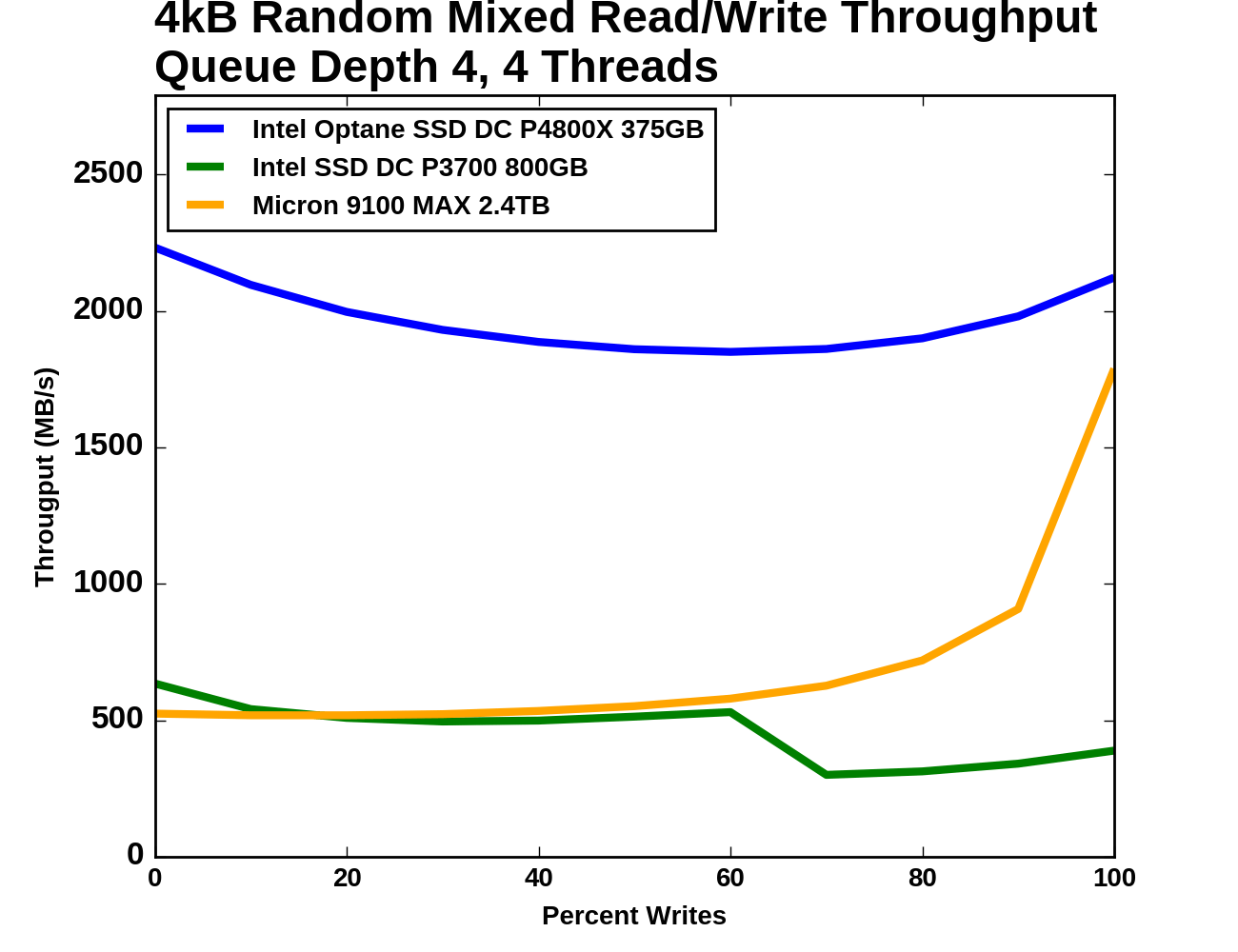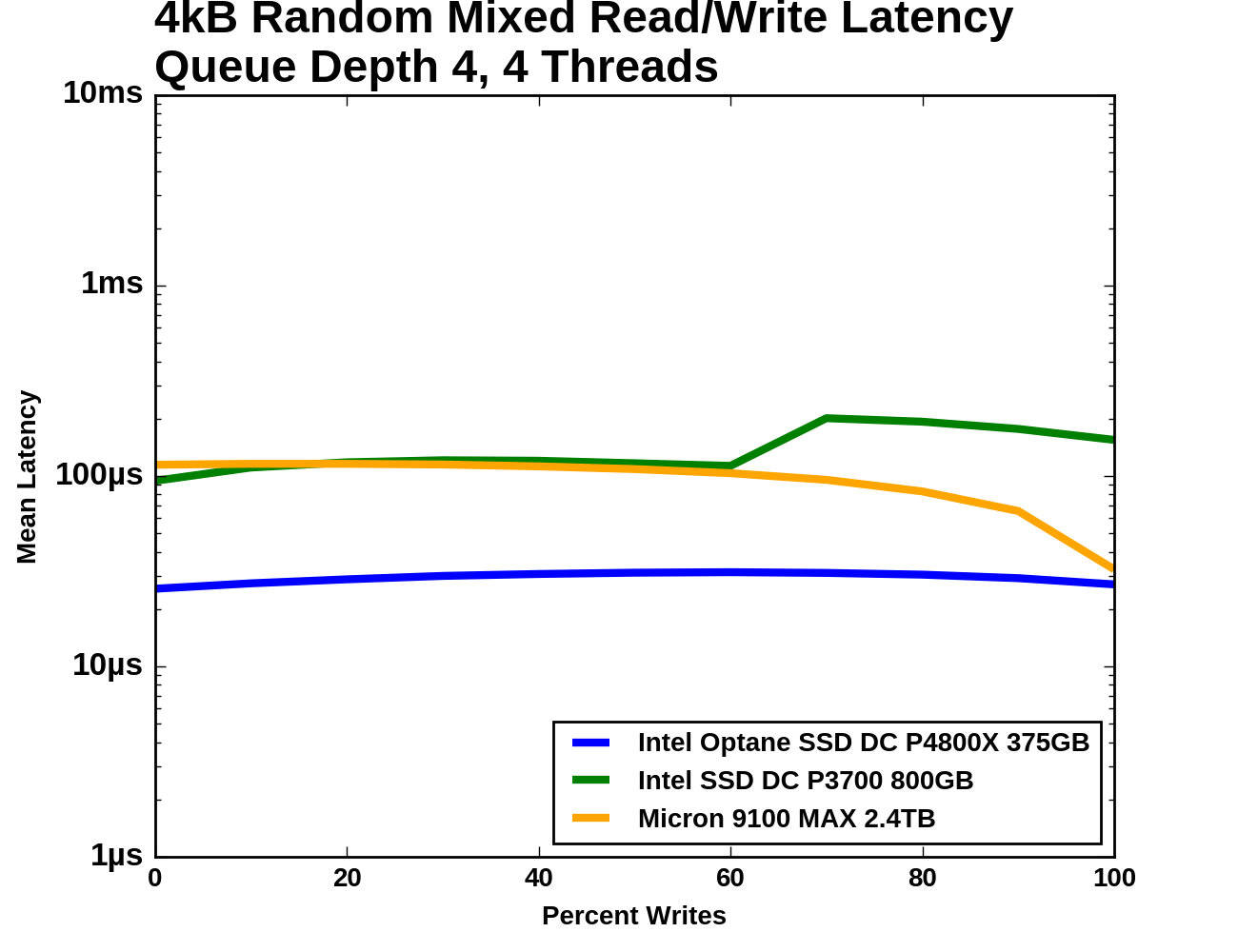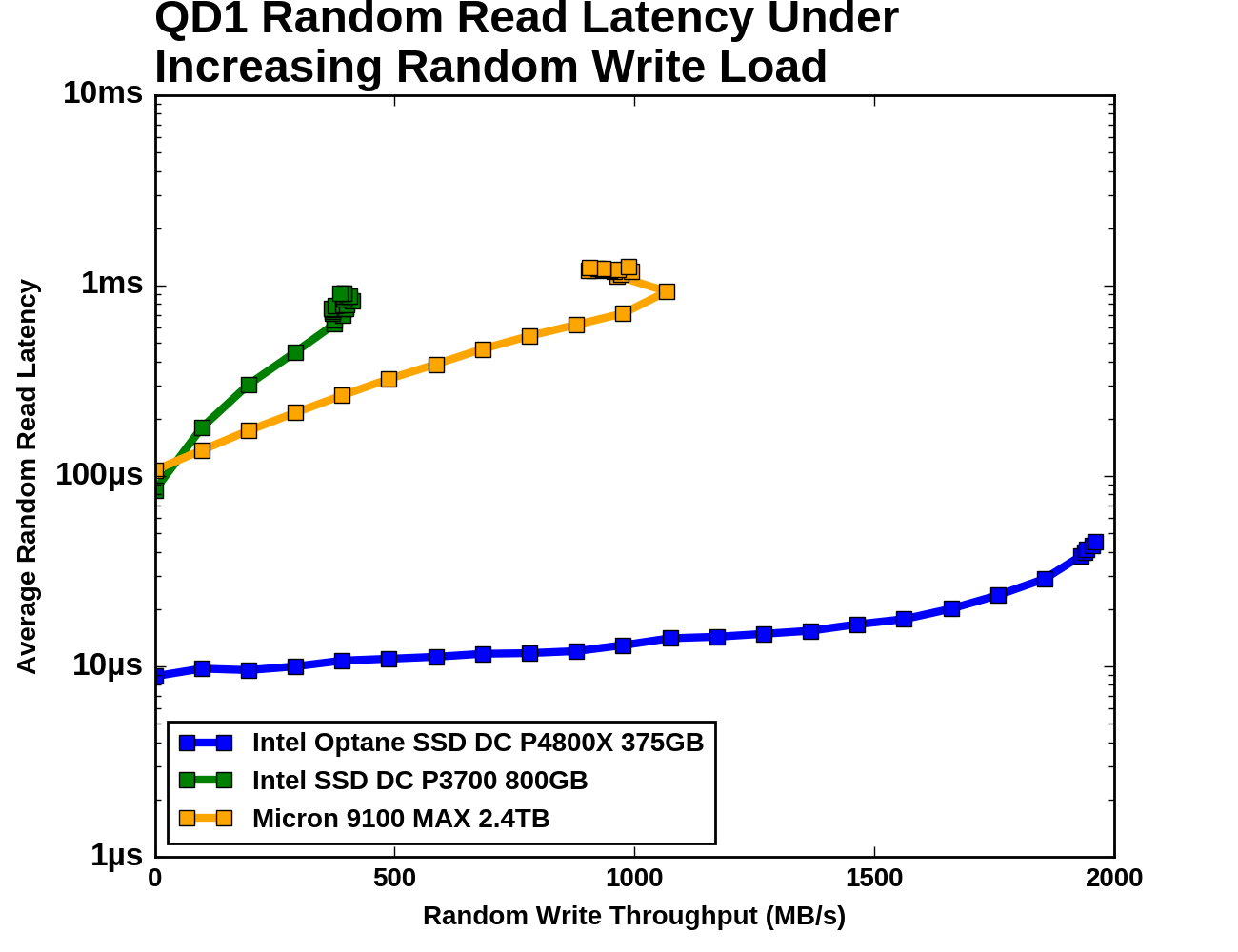The Intel Optane SSD DC P4800X (375GB) Review: Testing 3D XPoint Performance
by Billy Tallis on April 20, 2017 12:00 PM ESTMixed Read/Write Performance
Workloads consisting of a mix of reads and writes can be particularly challenging for flash based SSDs. When a write operation interrupts a string of reads, it will block access to at least one flash chip for a period of time that is substantially longer than a read operation takes. This hurts the latency of any read operations that were waiting on that chip, and with enough write operations throughput can be severely impacted. If the write command triggers an erase operation on one or more flash chips, the traffic jam is many times worse.
The occasional read interrupting a string of write commands doesn't necessarily cause much of a backlog, because writes are usually buffered by the controller anyways. But depending on how much unwritten data the controller is willing to buffer and for how long, a burst of reads could force the drive to begin flushing outstanding writes before they've all been coalesced into optimal sized writes.
The effect of a read still applies to the Optane SSD's 3D XPoint memory, but with greatly reduced severity. Whether a block of reads coming in has an effect depends on how the Optane SSD's controller manages the 3D XPoint memory.
Queue Depth 4
Our first mixed workload test is an extension of what Intel describes in their specifications for throughput of mixed workloads. A total queue depth of 16 is achieved using four worker threads, each performing a mix of random reads and random writes. Instead of just testing a 70% read mixture, the full range from pure reads to pure writes is tested at 10% increments.
 |
|||||||||
| Vertical Axis units: | IOPS | MB/s | |||||||
The Optane SSD's throughput does indeed show the bathtub curve shape that is common for this sort of mixed workload test, but the sides are quite shallow and the minimum (at 40% reads/60% writes) is still 83% of the peak throughput (which occurs with the all-reads workload). While the Optane SSD is operating near 2GB/s the flash SSDs spend most of the test only slightly above 500MB/s. When the portion of writes increases to 70%, the two flash SSDs begin to diverge: the Intel P3700 loses almost half its throughput and only recovers a little of it during the remainder of the test, while the Micron 9100 begins to accelerate and comes much closer to the Optane SSD's level of performance.
 |
|||||||||
| Mean | Median | 99th Percentile | 99.999th Percentile | ||||||
The median latency curves for the two flash SSDs show a substantial drop when the median operation switches from a read to a cacheable write. The P3700's median latency even briefly drops below that of the Optane SSD, but then the Optane SSD is handling several times the throughput. The 99th and 99.999th percentile latencies for the Optane SSD are relatively flat after jumping a bit when writes are first introduced to the mix. The flash SSDs have far higher 99th and 99.999th percentile latencies through the middle of the test, but much fewer outliers during the pure read and pure write phases.
Adding Writes to a Drive that is Reading
The next mixed workload test takes a different approach and is loosely based on the Aerospike Certification Tool. The read workload is constant throughout the test: a single thread performing 4kB random reads at QD1. Threads performing 4kB random writes at QD1 and throttled to 100MB/s are added to the mix until the drive's throughput is saturated. As the write workload gets heavier, the random read throughput will drop and the read latency will increase.
The three SSDs have very different capacity for random write throughput: the Intel P3700 tops out around 400MB/s, the Micron 9100 can sustain 1GB/s, and the Intel Optane SSD DC P4800X can sustain almost 2GB/s. The Optane SSD's average read latency increases by a factor of 5, but that still enough to provide about 25k read IOPS. The flash SSDs both experience read latency growing by an order of magnitude as write throughput approaches saturation. Even though the Intel P3700 has a much lower capacity for random writes, it provides slightly lower random read latency at its saturation point than the Micron 9100. When comparing the two flash SSDs with the same write load, the Micron 9100 provides far more random read throughput.











117 Comments
View All Comments
Billy Tallis - Friday, April 21, 2017 - link
I said the NVMe driver wasn't manually switched into polling mode; I left it with the default behavior which on 4.8 seems to be not polling unless the application requests. I'm certainly not seeing the 100% CPU usage that would be likely if it was polling.If I'd had more time, I would have experimented with the latest kernel versions and the various tricks to get even lower latency.
tuxRoller - Friday, April 21, 2017 - link
I wasn't claiming that you disabled polling only that polling was disabled since it should be on be default for this device.Assuming you were looking at the sysfs interface, was the key that was set to 0 called io_poll or io_poll_delay? The later set to 0 enables hybrid polling, so the cpu wouldn't be pegged.
Either way, you wouldn't need a new kernel, just to enable a feature the kernel has had since 4.4 for these low latency devices.
Also, did you disable the pagecache (direct=1) in your fio commands? If you didn't, that would explain why aio was faster since it uses dio.
Btw, it's not my intent to unnecessarily criticize you because i realize the tests were performed under constrained circumstances. I just would've appreciated some comment in the article about a critical feature for this hardware was not enabled in the kernel.
yankeeDDL - Friday, April 21, 2017 - link
Optane was supposed to be 1000x faster, have 1000X endurance and be 10x denser than NAND (http://hothardware.com/ContentImages/NewsItem/4020...I realize this is the first product, but saying that it fell short of expectation is an understatement.
It has lower endurance, lower density and it is measurably faster, but certainly nowhere close 1000X.
Oh, did I mention it is 5-10X more expensive?
I am quite disappointed, to be honest. It will get better, but @not ready@ is something that comes to ind reading the article.
Billy Tallis - Friday, April 21, 2017 - link
3D XPoint memory was supposed to be 1000x faster than NAND, 1000x more durable than NAND, and 10x denser than DRAM. Those claims were about the 3D XPoint memory itself, not the Optane SSD built around that memory.ddriver - Friday, April 21, 2017 - link
It is probably as good as they said... if you compare it to the shittiest SD card from 10 years ago. Still technically NAND ;)yankeeDDL - Monday, April 24, 2017 - link
I disagree. I can agree that the speed may be limited by the drive, but even so, it falls short by a large factor. The durability and the density, however, are pretty much platform independent and they are not there by a very, very long shot. Intel itself demonstrated that it is only 2.4-3X faster (https://en.wikipedia.org/wiki/3D_XPoint).It clearly has a future, especially as the NAND is approaching the end of its scalability. Engineering wise is interesting, but today, it makes really little sense, while it should have been a slam dunk. I mean, who would have thought twice before buying a 500GB drive that maxes out the SATA for $20-30? But this one ... not so much.
zodiacfml - Friday, April 21, 2017 - link
It will perform better in DIMM.factual - Friday, April 21, 2017 - link
I don't see xpoint replacing dram due to both latency and endurance not being up to par , but It's going to disrupt the ssd market and as the technology matures and prices come down, I can see xpoint revolutionizing the storage market as ssd did years ago.Competition is clearly worried since seems like paid trolls are trying to spread falsehoods and bs here and elsewhere on the web.
ddriver - Saturday, April 22, 2017 - link
I just bet it will be highly disturbing to the SSD market LOL. With its inflated price, limited capacity and pretty much unnecessary advantages I can just see people lining up to buy that and leaving SSDs on the shelves.factual - Saturday, April 22, 2017 - link
You are either extremely ignorant or a paid troll !!! anyone who understands technology knows that new tech is always expensive. When SSDs came to the market, they were much more expensive and had a lot less capacity than HDDs but they closed the gap and disrupted the market. The same is bound to happen for Xpoint which performs better than NAND by orders of magnitude.